Makna Pesan Komunikasi Nonverbal Pada Ritual Gua Meze di Kampung Adat Rendu Tutubhada, NTT
Abstract
The Gua Meze Ritual is a harvest thanksgiving ritual that is carried out in July according to the local community calendar. This ritual has 33 series which are divided into three major stages, namely Preparation, Ritual Celebrations and Restoration. This study examines the nonverbal meanings contained in rituals using the theory of Semiotics by Roland Barthes. Research in Traditional Villages Tutubhada Rendu Tutubhada Village, South Aesesa District, Nagekeo Regency was carried out with the aim of knowing the meaning of nonverbal communication messages in the Gua Meze ritual. This study uses a descriptive qualitative approach. The data source is based on literature review of previous research, observation, interviews, and documentation. The results achieved in this study are an explanation of the meaning of Denotation, Connotation and Myth in the Gua Meze ritual series in the Rendu Tutubhada Traditional Village.
Keywords: meaning, communication message, nonverbal, ritual, cave meze, thanksgiving harvest



